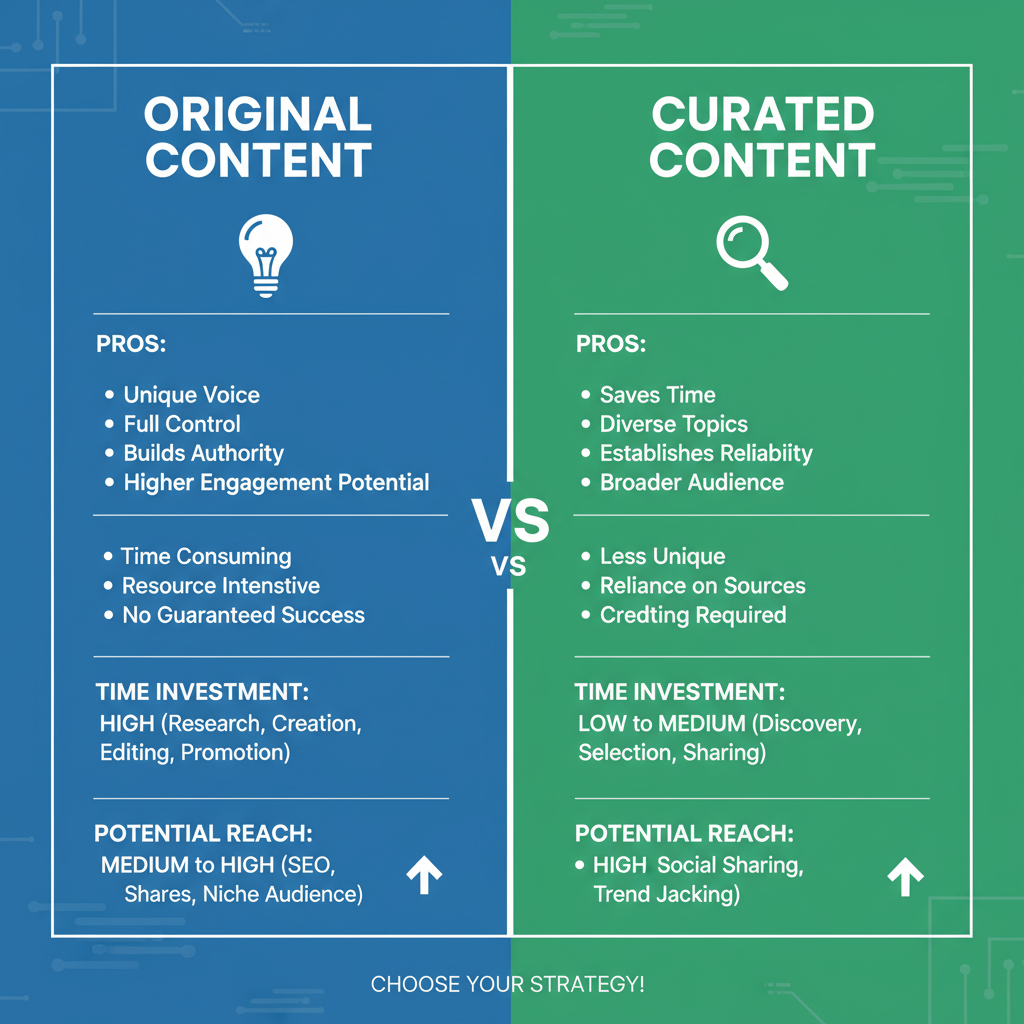Social Media Content Curation Strategies for Growth
Learn how to curate social media content effectively, from identifying audience needs to sourcing reliable materials and building a streamlined workflow.

Introduction to Social Media Content Curation
Social media content curation is a smart strategy for marketers and creators who want to maintain a consistent online presence without producing every piece of content from scratch. By selectively gathering, organizing, and sharing high‑quality material from reputable sources, you can engage followers, build authority in your niche, and keep your feed aligned with current industry trends. This guide will explain how to curate content effectively—from identifying audience needs to measuring performance—so you can maximize the impact of your social media marketing.

---
Understanding Social Media Content Curation
Social media content curation is the practice of gathering, organizing, and sharing relevant content created by others with your audience. Instead of producing new pieces from scratch, you hand‑pick materials that fit your brand’s theme, industry trends, and audience interests. When done strategically, content curation can strengthen your positioning as a thought leader, fill gaps in your content calendar, and improve engagement rates.
Curated content adds variety to your feed, saves production time, and provides value by giving your followers fresh perspectives from external sources.
---
Original Creation vs. Curated Content
While original content creation involves producing your own posts—articles, videos, infographics—curated content is selected from existing materials created by others.
Key distinctions:
- Ownership: You own original content; curated content belongs to someone else but you share it.
- Effort: Original requires ideation, design, and production; curated requires discovery and selection.
- Purpose: Original showcases your expertise directly; curated shows your ability to filter valuable insights from vast information.
The most effective social media strategies blend both to maintain authenticity while staying relevant.
---
Identifying Audience Needs and Preferred Formats
Before curating content, take time to understand:
- Who your audience is: demographics, interests, pain points.
- Preferred formats: blog articles, podcasts, videos, infographics, tweets.
- Platform norms: Instagram favors visuals, LinkedIn thrives on professional articles, X (Twitter) excels at quick industry updates.
Conduct surveys, monitor engagement analytics, and observe competitor feeds to identify what resonates most with your followers.
---
Selecting Reliable Sources
Reliable sources prevent misinformation and boost credibility. High‑quality sources include:
- Industry blogs & websites – authoritative insights, trends.
- Email newsletters – curated updates from trusted voices.
- Influencers & thought leaders – timely content, unique perspectives.
- Research publications – data‑backed findings.
When evaluating a source:
- Verify the author’s expertise.
- Check the publication date for relevance.
- Ensure factual integrity.
| Source Type | Strengths | Potential Drawback |
|---|---|---|
| Industry Blogs | Specialized expertise & timely topics | May be biased towards sponsor products |
| Email Newsletters | Well‑curated, concise updates | Not all provide deep analysis |
| Influencers | Large reach, personal recommendations | Content may lack rigorous verification |
| Research Publications | Data‑driven and credible | Can be lengthy and complex |
---
Building a Content Curation Workflow
A streamlined workflow ensures you deliver consistent value without being overwhelmed.
Discovery
Use RSS feeds, industry newsletters, and social listening tools to find content quickly.
Evaluation
Assess quality, relevance, timeliness, and alignment with brand values.
Scheduling
Set up a structured calendar to mix curated and original posts. A simple weekly schedule could be:
- 3 curated items from leading sources
- 2 original content pieces
- 1 engagement‑focused post (poll, quiz)

---
Social Media Tools for Curation
Leverage powerful tools to save time:
- Feedly – track topics via RSS feeds.
- Pocket – save articles for later review.
- Buffer – schedule posts across platforms.
Example: Spot a compelling blog post on Feedly, save it to Pocket, add commentary for context, and schedule it via Buffer at the optimal time.
---
Establishing Brand Voice in Curated Posts
Rather than simply reposting, add your commentary and context:
- Explain why the content matters.
- Relate it to current events.
- Highlight main points for your audience.
Example Caption:
> _"This insightful infographic from @IndustryLeader breaks down AI trends for 2024. We believe the rise in edge computing will reshape small business operations—do you agree?"_
Your unique tone ensures curated posts reinforce your brand identity.
---
Applying the 80/20 Rule to Your Feed
The 80/20 rule in content curation suggests:
- 80% value – educational, entertaining, or informative content (including curated pieces).
- 20% promotion – your own services, products, or events.
Maintaining this balance ensures your audience feels enriched rather than constantly sold to.
---
Leveraging Curated Content for Engagement
Turn curated posts into conversation starters:
- Polls – ask your audience’s opinion on a new report.
- Discussion threads – invite followers to share experiences.
- Q&A sessions – live responses to questions sparked by curated articles.
For example, share a case study from an influencer and ask followers how the findings apply to their business.

---
Measuring the Impact of Curated Content
Assess performance with metrics such as:
- Reach – total audience exposed.
- Engagement – likes, comments, shares.
- Follower growth – new audience gained.
Use native platform analytics or third‑party tools like Sprout Social to track results effectively.
---
Optimizing Based on Analytics and Feedback
Review your curated content performance regularly:
- Identify themes that drive high engagement.
- Adjust posting times and formats based on analytics.
- Incorporate audience feedback from comments or direct messages.
Example: If data shows video clips outperform images, prioritize sharing more video‑based curated content.
---
Legal and Ethical Considerations
When sharing others’ content:
- Credit the source clearly (author name, publication).
- Link back to the original work.
- Understand fair use — small excerpts with commentary may be permissible, but copying entire works can infringe copyright.
Best practice: Never remove watermarks or logos from visuals; always obtain explicit permission when in doubt.
---
Conclusion and Next Steps
Social media content curation, when approached with strategy and integrity, can accelerate growth, deepen engagement, and build authority. By blending reliable sources, efficient workflows, and a distinctive brand voice, you can keep your feed fresh and your audience loyal.
Start implementing these principles today: experiment with different formats, refine your workflow based on analytics, and maintain ethical sharing practices. Effective curation will transform your social presence into a trusted resource for your community—downloadable calendars and curation tools are great next steps to get started.




